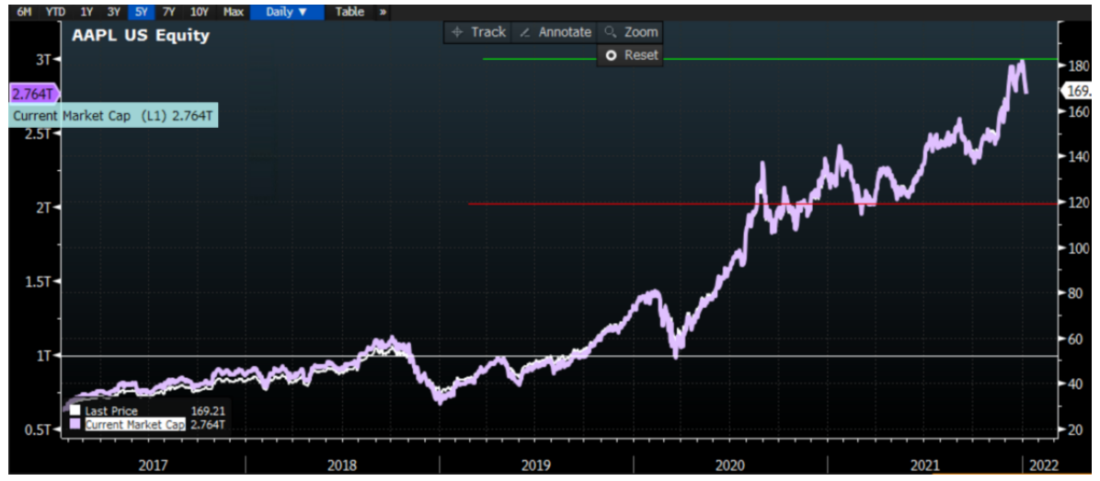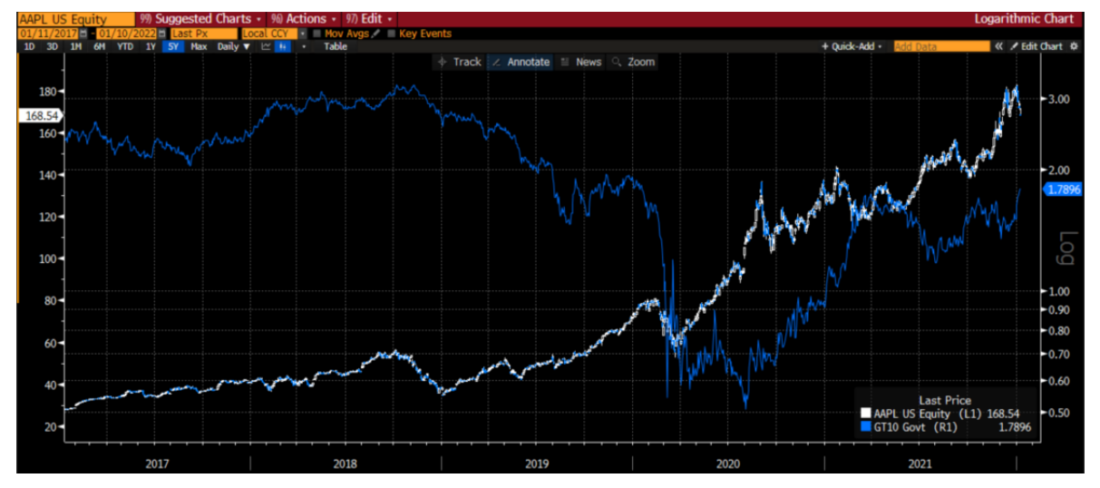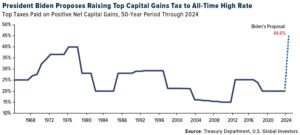A week ago today I got a well-timed text from my friend Ken, a financial advisor on the West Coast. He thought that the combination of Apple (AAPL) touching a $3 trillion valuation, a 16 handle on the CBOE Volatility Index (VIX), and bond yields that seemed ready to break out, made for a perfect setup for shorting the NASDAQ 100 Index (NDX). That was one heck of a call. QQQ is about 7.5% now than it was at the time of his text, while VIX is trading above 22, and 10-Year Treasury Note yields are about 13 basis points higher.
When we look back upon the events of the past week, it will be tempting to share my friend’s viewpoint that AAPL’s $3 trillion valuation was indeed a signal of a top. For starters, AAPL had to pass through $1 trillion and $2 trillion to get to $3 trillion, and neither of those events presaged a major market top, as shown below:
5 Year Daily Chart of AAPL Market Capitalization (purple, left scale) and Stock Price (white, right)

We see that AAPL’s first flirtation with a $1 trillion valuation preceded a fairly substantial market decline in the fourth quarter of 2018, though not immediately. We also see that level providing some resistance in 2019 before powering higher when the Fed eased monetary conditions in response to the repo crisis that was brewing in the fourth quarter of that year. The stock was hardly impeded when it doubled its valuation to $2 trillion less than a year later, though we saw support at that valuation at various times in 2021. Is it any surprise that we saw a bit of a pullback after AAPL further increased its market cap by another 50% in about 6 months?
So what changed between then and now? One could certainly assert that rising rates had a negative effect on tech stock valuations. Financial media has been pointing out that for some time. While there is truth in that rationale, I am somewhat dismissive of the correlation between the two. On the same day that AAPL reached its milestone valuation, we wrote the following:
“Quite frankly, I don’t buy the assertion that there is a tight link between 10-year yields and the valuation of major tech stocks. Let’s be clear, I am not dismissing the fundamentals of corporate valuation. I most certainly believe that stock prices reflect investor views of the future value of corporate cash flows. But there is another variable that is much harder to model, and that is the multiple that investors are willing to pay for those future flows. Those are highly dependent about investor sentiment. Many of the most highly valued tech stocks do indeed display steadily rising earnings, but they also benefit from investors’ continuing willingness to pay a premium price for a claim on those earnings. In other words, valuations matter, but not as much as investor enthusiasm.”
Please consider the following chart for further evidence. It shows AAPL’s price on a logarithmic scale plotted against 10-year note yields on a normal scale.
AAPL Daily Prices (white/blue bars, right scale, logarithmic) vs 10-Year Note Yields (blue line, left)


Indeed, AAPL’s stock price seemed to benefit from falling yields from 2017 through 2020. But since yields bottomed in mid-2020, both have proceeded higher. I would assert that AAPL was far more responsive to the rising Fed balance sheet and investor enthusiasm than it was to the valuation implications of rising yields. Only now, when it appears that the firehose of Fed-provided liquidity is likely to abate, do conventional valuation considerations seem to be arising.
Less than a month ago, in the aftermath of the December FOMC meeting, we noted that the bond market appeared to be ignoring the Fed’s dot plot. The 2-year note was pricing in fewer rate hikes than the Fed indicated. That perception changed dramatically once the minutes to that meeting were released last week. Investor opinion appeared to turn more negative almost immediately, and markets have been under pressure ever since. While my friend’s market call was a brilliantly timed one, the $3 trillion valuation of AAPL, while a reflection of high animal spirits (if not outright greed), was more a coincidental symptom rather than the proverbial bell ringing at a market top.
—
Charts source: Bloomberg
Disclosure: Interactive Brokers
The analysis in this material is provided for information only and is not and should not be construed as an offer to sell or the solicitation of an offer to buy any security. To the extent that this material discusses general market activity, industry or sector trends or other broad-based economic or political conditions, it should not be construed as research or investment advice. To the extent that it includes references to specific securities, commodities, currencies, or other instruments, those references do not constitute a recommendation by IBKR to buy, sell or hold such investments. This material does not and is not intended to take into account the particular financial conditions, investment objectives or requirements of individual customers. Before acting on this material, you should consider whether it is suitable for your particular circumstances and, as necessary, seek professional advice.
The views and opinions expressed herein are those of the author and do not necessarily reflect the views of Interactive Brokers, its affiliates, or its employees.
Disclosure: Margin Trading
Trading on margin is only for sophisticated investors with high risk tolerance. You may lose more than your initial investment. For additional information regarding margin loan rates, see ibkr.com/interest
Disclosure: Futures Trading
Futures are not suitable for all investors. The amount you may lose may be greater than your initial investment. Before trading futures, please read the CFTC Risk Disclosure. A copy and additional information are available at ibkr.com.


































